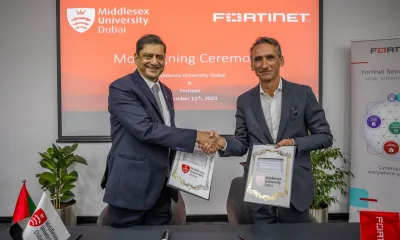Cyber Security
Spire Solutions to Show Off Latest Cybersecurity Solutions at GITEX Global 2023

Spire Solutions has announced its participation in GITEX Global 2023, scheduled to take place from 16th to 20th October 2023, at the Dubai World Trade Centre. Spire Solutions will be present at booth B30, Hall 23 along with renowned cybersecurity and data technology partners such as Corelight, CyberArk, Cyberbit, White Shark, ForgeRock, Gurucul, and Spire Data.
Amidst the industry’s buzz around Artificial Intelligence supercharging the global security and technology race, this year our spotlight is on demonstrating the transformative potential of AI in reshaping the cybersecurity, technology, and data industry. Under the theme “Powering AI-driven Cybersecurity, Digital, and Data Revolution,” our focus will be on the most powerful and influential solutions that will help secure the Tech, and Data ecosystem and enhance the cybersecurity landscape of the region.
Sanjeev Walia, Founder and President at Spire Solutions said, “GITEX brings together the most influential network and provides a unique platform to engage with industry leaders, partners, and customers, to foster meaningful connections and drive technological growth. Given our prominent position and extensive experience in the region, we view GITEX as an ideal platform to meet and enlighten our customers about the imperative of building a modern, secure, and agile cybersecurity infrastructure necessary to respond to dynamic cyber threats. Our goal is to bring an integrated approach to relevant strategies and introduce innovative & disruptive solutions to help government and private entities achieve digital and data transformation. At GITEX 2023 will announce strategic partnerships, organize high-profile meetings around special projects, and showcase live demos of our niche technologies across all 5 days.”
“Spire Solutions is dedicated to strengthening the region’s cybersecurity ecosystem with best-in-class security solutions and data practices & standards. With Corelight in the spotlight, we will demonstrate how businesses of all sizes can effectively manage their network security and disrupt future attacks with next-level analytics, and an expert threat-investigation platform,” the company said.
“To seamlessly secure identities across diverse infrastructure types, including hybrid, SaaS, and multi-cloud environments, we have CyberArk with its end-to-end Privileged Access Management (PAM) and Identity Access Management solutions that offer the most complete and extensible identity security platform, protecting identities and critical assets by enabling zero trust and enforcing least privilege,” the company added.
“Cyberbit will exhibit the world-leading cyber range, which helps in delivering hyper-realistic cyberattack simulations to help maximize the skills of information security teams. White Shark brings AI-powered sustainable technology with effortless cross-platform integration, offering a wide array of services (BaaS) and platforms (PaaS) with an aim to revolutionize the transition to Web3 and Blockchain for enterprises and make it seamless and accessible in a truly decentralized manner,” the company explained.
“ForgeRock brings the power to manage, secure, and govern all digital identities and rethink the role of traditional passwords with its passwordless authentication solution. Gurucul’s Next-Gen SIEM helps transform the security operations centre with actionable machine learning and analytics. It further supports in automating manual processes and empowers teams to act on data-driven insights. Through our bespoke data company Spire Data, we will illustrate how to seamlessly access, integrate, and govern data across both cloud and on-premises environments, effectively empowering your ongoing digital & data transformation initiatives,” the company concluded.
Cyber Security
Data Stealers Are Hunting for User Credentials, Says Kaspersky

As the malware development market continues to flourish with new stealers such as Lumma, for the last three years Redline still remains the dominant data-stealing malware used by cybercriminals. More than half of every device (55%) targeted by password-stealer attacks in 2023 has been infected with the Redline malware, Kaspersky Digital Footprint Intelligence finds.
Infostealers infiltrate devices to illicitly obtain sensitive credentials such as logins and passwords, which are then peddled on the shadow market, posing significant cybersecurity threats to personal and corporate systems. According to information gleaned from log files traded or distributed freely on the dark web, Redline was used in 51% of infostealer infections from 2020 to 2023. Other notable malware families included Vidar (17%) and Raccoon (nearly 12%). In total, around 100 distinct infostealer types were identified by Kaspersky Digital Footprint Intelligence between 2020 and 2023 using metadata from log files.
The underground market for data-stealing malware development is expanding, evident from the rising popularity of new stealers. Between 2021 and 2023, the portion of infections caused by new stealers grew from 4% to 28%. Specifically, in 2023, the new “Lumma” stealer alone was responsible for more than 6% of all infections.
“Lumma emerged in 2022 and gained popularity in 2023, through a Malware-as-a-Service (MaaS) distribution model. This means any criminal, even those without advanced technical skills, can purchase a subscription for a pre-made malicious solution and use this stealer to carry out cyberattacks. Lumma is primarily designed for stealing credentials and other information from cryptocurrency wallets, commonly spread through email, YouTube, and Discord spam campaigns,” said Sergey Shcherbel, an expert at Kaspersky Digital Footprint Intelligence.
To guard against data-stealing malware, individuals are advised to use a comprehensive security solution for any device. This will help prevent infections and alert them to dangers, such as suspicious sites or phishing emails that can be an initial vector for infection. Companies can help their users, employees and partners protect themselves from the threat by proactively monitoring leaks and prompting users to change leaked passwords immediately.
Channel Talk
AmiViz Joins Signs Up with Abstract Security

AmiViz has forged a partnership with Abstract Security, a cyber threat operations platform offering a revolutionary approach to security analytics that allows organisations to improve efficiency, reduce SIEM-related storage costs, and enhance detection and response capabilities across multi-cloud and on-premise environments. The Abstract platform disrupts traditional cybersecurity analytics with its innovative approach, challenging the limitations of conventional Security Analytics systems. Abstract Security offers a transformative cyber threat operations platform in an era marked by compliance-induced data swamps and redundant data storage.
“Engineered to streamline security analytics, it enhances detection and response capabilities across diverse IT environments, including multi-cloud and on-premise setups. By integrating tactical artificial intelligence (AI), Abstract empowers security analysts to decode complex cloud security data, improving detection strategies and filling visibility gaps. Pioneering initiatives like the decentralized edge computing platform and a one-click data lake further solidify Abstract Security’s position as a visionary player in cybersecurity,” the company said.
“The strategic expansion into Middle Eastern markets aligns with the region’s growing demand for advanced cybersecurity measures. With rapid digital transformation and increased cyber threats, the Middle East presents a significant opportunity for Abstract Security. Government investments in cybersecurity infrastructure and the adoption of IoT technologies amplify the demand for efficient, AI-driven security solutions,” the company added.
Ilyas Mohammed, COO at AmiViz, said, “Our partnership with Abstract Security heralds a new era in cybersecurity analytics. By leveraging their innovative solutions, we empower our clients with proactive threat management capabilities that surpass traditional systems. Together, we redefine industry standards, ensuring robust protection against evolving cyber threats and bolstering our position as leaders in the cybersecurity landscape.”
Richard Betts, Vice President of International Business at Abstract Security, commented on the strategic alliance, stating, ‘Our collaboration with AmiViz in the Middle East is more than a partnership; it’s a synergy of strengths. This venture not only amplifies our presence in a region but also marks a significant step in our journey to broaden Abstract Security’s international reach.
The companies claimed that the solutions are tailored for large enterprises in critical sectors like finance, oil and gas, telecommunications, MSSP and government, to address unique cyber threats. Abstract Security said it aims to integrate its solutions in local markets deeply through a channel-focused distribution strategy, empowering channel partners and addressing evolving security needs. The company added that it has partnered with AmiViz to provide comprehensive support, including technical training, marketing assistance, and dedicated account management, further strengthening Abstract Security’s position in the GCC markets.
Abstract Security’s partnership with AmiViz allows Middle Eastern channel partners to revolutionize security analytics, transcending traditional SIEM systems and compliance burdens. Together, they set a new standard for cybersecurity analytics, paving the way for proactive and predictive security measures. This partnership aims to position the Middle East as a cybersecurity stronghold, contributing to its global leadership in cybersecurity.
Cyber Security
Check Point Software Technologies to Participate at GISEC 2024

Check Point Software Technologies has announced its participation at the Gulf Information Security Expo & Conference (GISEC) 2024, scheduled from April 23rd to April 25th, 2024, at the Dubai World Trade Centre. As cyber threats continue to evolve rapidly, the need for advanced cybersecurity solutions has never been more pressing. With the United Arab Emirates experiencing an average of 1,207 cyberattacks per organization each week over the last six months—surpassing the global average—Check Point Software is set to showcase its flagship Check Point Infinity Platform at GISEC 2024.
This platform, which is at the forefront of AI-powered, cloud-delivered cybersecurity, has been specifically designed to meet the modern challenges of an evolving threat landscape, providing comprehensive protection, consolidated operations, and collaborative communication capabilities. Visitors can explore these solutions at booth #C39 in Hall 7, where the following highlights will be featured:
- Check Point Infinity Playblocks: Automatically triggers preventive actions upon detecting an attack, swiftly containing threats through a consolidated, cloud-based security platform.
- Check Point Infinity AI Copilot: Enhances the efficiency of security teams by leveraging AI to automate complex tasks and deliver proactive security solutions.
- Check Point UAE Infinity Portal: Tailored to meet the needs of organizations of all sizes while fully adhering to the UAE’s data privacy regulations.
Ram Narayanan, Country Manager at Check Point Software Technologies Middle East, commented, “Our participation at GISEC 2024 underscores our commitment to bolstering cybersecurity defences in the region. The Check Point Infinity Platform, with its AI-powered threat prevention and cloud-delivered threat intelligence, is critical for organizations needing robust solutions to protect their assets. We look forward to engaging with customers and partners to discuss how these innovations can enhance cybersecurity resilience.”
Additionally, at GISEC 2024, Check Point Software will focus on strengthening relationships with customers and partners. This commitment highlights the company’s ongoing effort to provide advanced cybersecurity solutions in the region. Check Point Software is eager to meet with attendees, discuss their security challenges, and explore how it can help organizations enhance their defences, prevent cyber-attacks, and protect their critical assets.
-

 GISEC1 week ago
GISEC1 week agoPositive Technologies to Knock Out Email Threats at GISEC 2024 with New Service
-

 Critical Communications6 days ago
Critical Communications6 days agoAirbus to Show Off its New Generation of Hybrid Solutions at CCW 2024
-

 GISEC1 week ago
GISEC1 week agoMansoor bin Mohammed Opens GISEC Global 2024 at DWTC
-

 News7 days ago
News7 days agoSnowflake Launches Arctic LLM for Enterprises
-

 GISEC1 week ago
GISEC1 week agoCyberKnight Launches New OT/IoT Security Unit and Announces TXOne Partnership
-

 GISEC1 week ago
GISEC1 week agoTrend Micro Highlights Unified Cyber Security Platform at GISEC 2024
-

 Critical Communications7 days ago
Critical Communications7 days agoTCCA and GCF to Develop Industry Certification Program for Mission-Critical Products and Solutions
-

 Critical Communications World7 days ago
Critical Communications World7 days agoHytera’s Theme at CCW 2024 will be ‘Innovate for a Safer World’

























